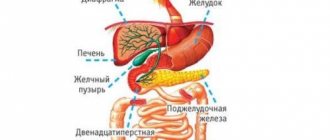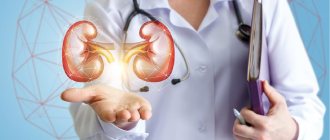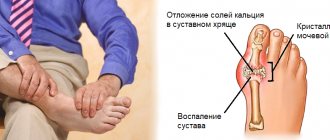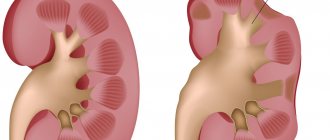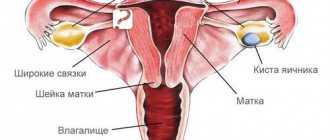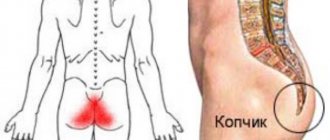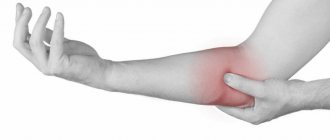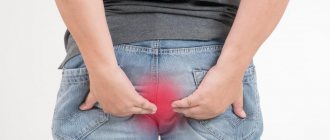The appearance of acute pain in the kidney area practically always indicates the presence of a certain problem in the urinary system of the human body. It can arise suddenly, against the background of absolute well-being. May accompany various chronic diseases.
The kidneys are a paired parenchymal organ with a bean-shaped shape. Many people believe that the kidneys are only responsible for producing urine. In fact, they play a much more important role in the human body:
- Remove harmful toxins from the body;
- Participate in maintaining water and electrolyte balance in the body;
- They produce erythropoietin, a hormone that stimulates hematopoiesis;
- Produce vitamin D;
- Participate in the regulation of blood pressure, etc.
Every year in Russia, about 4%-6% of the population suffers from kidney disease, and the majority of nephrology patients are women. Do not forget that most kidney pathologies pose a real threat to the patient’s health and can be fatal. Often, kidney disease is asymptomatic, therefore, even the appearance of minor pain in the kidney area on the left or right should be a good reason to contact a specialist.
Specialists at the Yusupov Hospital diagnose and treat patients with various diseases of the urinary system. The hospital is equipped with the latest equipment, allowing each patient to be examined using innovative techniques. The therapy clinic employs doctors of the highest category, who are recognized experts in the field of nephrology. In complex medical cases, the patient will always be consulted by a council of hospital doctors headed by a professor. The Yusupov Hospital has not only its highly qualified medical staff, but also comfortable conditions for nailing.
Causes of kidney pain
Pyelonephritis
In an acute process, lower back pain begins suddenly, against the background of complete health.
Unpleasant sensations spread along the ureter, less often - radiating to the anterior abdominal wall. The symptom usually appears after hypothermia, with inflammation of the urethra and bladder. The clinical picture is complemented by febrile fever, chills, and malaise. Occasionally, dyspepsia is a concern. With a recurrent version of chronic pyelonephritis, mild aching pain in the lumbar region is observed. The symptom is accompanied by abdominal discomfort, pain when urinating, and periodic fever. Such clinical signs persist for several months. A combination of kidney pain and high blood pressure is typical.
Glomerulonephritis
Acute glomerulonephritis is manifested by moderate pain in the lower back, which is caused by stretching of the kidney capsule. The disease typically develops pain 2-3 weeks after a streptococcal or viral infection. In addition to pain, morning swelling occurs, which is noticeable after sleep and is mainly located on the face. Daily diuresis often decreases, and less often the pink color of urine is detected.
In the chronic form of glomerulonephritis, the patient occasionally experiences mild pain in the kidney area. Signs of arterial hypertension with significant daily fluctuations in pressure readings come to the fore. As with the acute form, constant swelling is observed, most pronounced in the morning. Worried about shortness of breath and other symptoms of heart failure.
Urolithiasis disease
ICD with small stones is asymptomatic for a long time. Occasionally, mild pain occurs on the side of the affected kidney. A typical clinical picture of renal colic appears when the ureter is blocked by a stone. An intense pain syndrome develops, which does not depend on changes in body position. Patients behave restlessly, trying to find a position in which the pain will decrease. Later hematuria occurs.
Hydronephrosis
Acute hydronephrosis is manifested by sharp paroxysmal pain in the projection of the affected kidney. They spread along the ureter, radiating to the thigh and perineum. This disease is characterized by frequent and painful urge to urinate, nausea, and vomiting. With infected hydronephrosis, the pain syndrome intensifies and is combined with an increase in temperature to febrile values.
Nephroptosis
With moderate prolapse of the kidneys, a nagging one-sided pain is felt in the lower back, and discomfort and heaviness in the abdominal cavity are also typical. Discomfort increases with bending over and physical activity, and disappears in a horizontal position. With severe nephroptosis, pain becomes constant and does not depend on posture. With a complicated course of the disease, an attack of pain begins, similar to renal colic.
Kidney infarction
The intensity of pain is influenced by the scale of organ damage. With a massive heart attack, severe pain suddenly develops, which is similar in intensity to renal colic. They are localized on one side. Due to excruciating pain, patients are restless, rush around the room, and cannot find a comfortable position. The pain syndrome is accompanied by hematuria, which is manifested by the discharge of pink or red urine.
Renal vein thrombosis
Pathology belongs to the category of emergency conditions. Thrombosis is characterized by acute pain in the projection of the kidneys and lateral abdomen. In addition to the pain syndrome, the patient feels a sharp deterioration in his condition, signs of intoxication increase - nausea and vomiting, weakness, drowsiness. Systemic signs of the disease are often observed: pain in the lower extremities, swelling and pastiness.
Neoplasms
Benign cysts remain silent for a long time. Pain in the kidney develops when the neoplasm increases in size, squeezing surrounding tissues and nerve endings. Pain sensations radiate to the groin and thigh. When large formations suppurate, chills and fever are observed, and the pain intensifies. Severe pain caused by physical activity indicates a threat of cyst rupture.
In kidney cancer, pain is a sign of an advanced process. The pain is one-sided, dull, aching in nature. They are caused by stretching of the organ capsule and invasive tumor growth. At the initial stages there is no pain. With malignant neoplasms of the kidney, a natural sequence of symptoms is observed: first, blood is detected in the urine, and then pain occurs in the lumbar area.
Rare causes
- Kidney failure
: acute and chronic. - Interstitial nephritis.
- Purulent processes
: apostematous nephritis, renal carbuncle, pyonephrosis. - Congenital anomalies
: horseshoe kidney, aplasia or dysplasia of the kidney, polycystic disease. - Nephropathy
: toxic, gouty, paraneoplastic. - Hepatorenal syndrome.
Epidemiology of UTIs
The content of the article
Urinary tract infections are one of the most common infectious diseases in humans.
The incidence of UTI depends on the sex and age of the subjects, as well as on the specific characteristics of the study population.
- In the neonatal period, UTI is detected in approximately 60% of cases in boys, which is associated with a higher incidence of congenital urinary tract defects.
- From the age of three months, this trend is reversed, and the incidence of urinary tract infections in girls and women is ten times higher than in their male counterparts.
- Every second woman suffers from cystitis at least once in her life, and 10% of sexually active women develop UTIs once a year.
- Urinary tract infections are rare in men under 50 years of age, but in patients over 60 years of age the number of reported cases is growing rapidly. This is associated with the appearance of bladder obstruction, most often in the form of benign prostatic hyperplasia.
- The incidence of UTIs is much higher among people hospitalized for any reason or living in nursing homes or nursing homes.
Benign Prostatic Hyperplasia
The risk of UTI increases when there is an obstruction to the flow of urine or when circumstances favor bacterial colonization and growth. Physiological factors that predispose to UTIs include pregnancy, old age, and medical conditions such as diabetes and urolithiasis.
Diagnostics
When collecting anamnesis, the nephrologist takes into account the duration of symptoms and the events that preceded the manifestation of the disease. During a physical examination, Pasternatsky's symptom is checked and edema is searched for. Laboratory and instrumental research data are decisive for identifying the causes of pain in the kidneys. Diagnostics includes the following methods:
- Urine tests.
In kidney pathology, several specific changes are observed: the presence of protein, cellular elements (erythrocytes, leukocytes), cylinders. To assess the concentration function, a urine test is performed according to Zimnitsky, to confirm hematuria or leukocyturia - a study according to Nechiporenko. - Blood tests.
Leukocytosis and increased ESR in the hemogram indicate the inflammatory nature of the disease. In a biochemical blood test, attention is paid to the level of total protein, albumin, and lipid profile. Assess creatinine and urea levels. - Ultrasound of the kidneys.
Sonography examines the size, contours and thickness of the renal parenchyma. According to ultrasound data, dilation of the pyelocaliceal system is established, and stones are detected in the kidneys or urinary tract. Renal blood flow is assessed using Doppler ultrasound. - Excretory urography.
The technique provides detailed visualization of the structure of the kidneys and urinary tract. Based on the results of this method, changes in the size of the organ, its deformation are revealed, and the excretory function of the kidneys is assessed. Urography is supplemented with other X-ray studies - CT, scintigraphy. - Kidney biopsy.
Invasive research data are required for the differential diagnosis of chronic glomerulonephritis, autoimmune kidney damage, and neoplasms. When performing a cytological examination of biopsy specimens, attention is paid to infiltration with leukocytes, the presence of immune complexes, and atypical cells.
Etiology and pathogenesis of UTI
The most common causes of UTIs are bacteria, and less commonly viruses, fungi, or parasites. The prevalence of certain types of bacteria isolated from patient urine depends largely on the population being studied. The situation is completely different for patients receiving outpatient treatment than for patients in hospitals.
Under physiological conditions, the urinary tract is sterile except at the end of the urethra. The first episode of UTI in an outpatient setting is caused by Escherichia coli in 80% of cases, Staphylococcus saprophyticus in 10-15% (except for the group of young sexually active women, in which it accounts for about 30%), other gram-negative bacteria (Proteus mirabilis, Klebsiella spp.) or gram-positive (staphylococci, streptococci, enterococci). 70% of recurrent community-acquired infections are caused by Escherichia coli. Also, the most common nosocomial infections are caused by Escherichia coli (about 50%), Enterobacter spp., Pseudomonas spp., Serratia marcescens, as well as staphylococci, enterococci and fungi.
Escherichia coli
In 95% of patients, a UTI is the result of infection with a single strain of bacteria. Infection with several strains is observed in 5% of patients, mainly in catheterized patients with weakened immunity, neurogenic bladder disorders or defects of the urinary system.
Infection of the urinary system can occur through the ascending route (urogenic infections), the bloodstream (hematogenous infections - very rarely caused mainly by Staphylococcus aureus), the lymphatic route, or continuously (in the presence of a urogenital or urogenital fistula).
A UTI is almost always caused by bacteria entering the urethra. Under physiological conditions, bacteria often enter the urinary tract, but due to the body's defense mechanisms, the development of UTIs is rare.
The most important natural defense mechanisms against UTIs are:
- length of the urethra in men;
- ureteral peristalsis, normal function of vesicoureteral valves;
- acidification and concentration of urine;
- correct bacterial flora of the vagina and area around the urethra;
- antibacterial properties of prostate secretion;
- mechanisms for preventing bacterial adhesion in the urinary tract: mechanical impact of a stream of urine, mucopolysaccharides of the bladder wall, IgG and IgA antibodies.
Urinary tract infections rarely occur in healthy people with normal anatomical structure and physiological function of the urinary tract. In case of obstructed urine outflow or weakening of the body due to systemic diseases (diabetes, gout, tumor process), we often encounter inflammatory changes in the urinary system.
Gout
The most common factors contributing to the development of a urinary tract infection include:
- 1st pregnancy,
- old age,
- obstruction to the outflow of urine – urolithiasis, prostate adenoma,
- atrogenic factors – urinary tract instrumentation (cystoscopy, bladder catheterization, ascending pyelography),
- congenital malformations of the urinary tract – double cup-pelvic system, retrograde vesicoureteral outflow,
- diabetes, gout,
- neurogenic bladder,
- end-stage renal failure (dialysis),
- sexual relations,
- prolonged immobilization in bed.
Urine in the urinary tract of a healthy person is sterile. The presence of bacteria in it indicates infection.
The main symptom for diagnosing a UTI is the so-called significant bacteriuria, when the number of bacteria in 1 ml of fresh, aseptically collected urine exceeds 100,000.
The occurrence of significant bacteriuria by gender and age is presented below:
| Age | women | Men |
| School age | 1% | 0,03% |
| 15-25 years | 3% | 0,5% |
| 30-35 years | 5-10% | up to 1% |
| 50-70 years | > 10% | up to 4% |
| over 80 years old | > 20% | > 10% |
In people with dysuria, the presence of up to 100 bacteria may indicate a urinary tract infection. Treatment for UTIs should begin as soon as clinical symptoms appear.
Tasks of a urologist:
- fight against bacteriuria,
- refusal of instrumentation of the urinary tract - bladder catheterization,
- proper treatment of systemic diseases.
Treatment
Help before diagnosis
If symptoms of acute nephritis or renal colic occur, the patient is immediately sent for hospital treatment. For mild to moderate cases, outpatient therapy is possible. Until the cause of the pain syndrome is identified, therapeutic measures include organizing a gentle regimen, selecting a diet with limited salt. To alleviate a person’s condition, symptomatic therapy is carried out.
Conservative therapy
The patient management plan is determined by the clinical form of the disease and the etiological factor. For all types of pathology, strict monitoring of the amount of fluid consumed and the volume of diuresis is indicated in order to monitor the excretory and concentration function of the kidneys. Some nephrological diseases require limiting protein intake. Drug therapy includes a number of drugs:
- Diuretics
. Allows you to normalize diuresis and reduce swelling. Loop, thiazide and potassium-sparing diuretics are used depending on the electrolyte composition of the blood. Diuretics are recommended only if the urinary tract is normal. - Corticosteroids
. The drugs quickly stop inflammation and have an immunosuppressive effect. They affect the cause of the disease, so kidney pain disappears quite quickly. Hormones are mainly used for glomerulonephritis and interstitial nephritis. - Antibiotic therapy
. Etiotropic antibacterial drugs are administered for pyelonephritis and other infectious kidney damage. Antibiotics from the group of cephalosporins and fluoroquinolones are predominantly prescribed. For mild forms of infection, uroseptics are effective. - Antihypertensive drugs
. Chronic kidney disease is accompanied by hypertension, for the treatment of which ACE inhibitors and angiotensin-II receptor blockers are selected. Calcium antagonists are also prescribed to normalize blood pressure. - Detoxification products
. Detoxification therapy is advisable for acute processes that are provoked by toxic influences. Specific antidotes are introduced, infusion therapy, and extracorporeal detoxification techniques are carried out.
If renal function is significantly impaired, replacement therapy is required - hemodialysis or peritoneal dialysis. The criteria for starting treatment are pathological creatinine levels and insufficient glomerular filtration rate, changes in potassium levels in the blood, the presence of life-threatening complications, and renal failure.
What to do if your side hurts
For any pain in the abdomen or back, you do not need to endure, diagnose and treat yourself. It is impossible to cure kidneys without knowing the cause of inflammation. Therefore, you must make an appointment with a doctor.
Even the most detailed description of pain in the side is not enough to make a diagnosis, and therefore the doctor will prescribe the patient to undergo a comprehensive study of the functioning of the urinary system.
Professional medical urologists are ready not only to identify the cause of pain in the side, but will also be able to save the patient from this pathology, restoring health and joy of life.
If you find an error, please select a piece of text and press Ctrl+Enter
Urethritis
Most often, the disease is associated with sexual contact, catheterization or endoscopy of the bladder. Urethritis always occurs in patients with an indwelling urinary catheter. The opening of the urethra is red, patients complain of a number of symptoms:
- burning pain and itching in the urethra;
- leakage of mucous, glassy or purulent discharge;
- lower abdominal pain.
Until recently, the most common cause of urethritis was gonorrhea. The infections are now twice as likely to be caused by Chlamydia trachomatis and Ureoplasma urealyticum. In 30% of cases, gonorrhea infection coexists with two others.
Urethritis
Standard urine cultures are often sterile, followed by immunological tests and isolation of microorganisms on specially prepared media.
The most common treatments are a single dose of fluoroquinolones and doxycycline for 7 days.
Recurrent urinary tract infections
Recurrent UTIs are caused by the same pathogen as the first case, usually within 2 weeks after stopping treatment. Mostly relapse occurs in women, and most often it is inflammation of the bladder. After the first episode of urinary tract infection, approximately 20% of UTIs are rediagnosed within one year.
Causes of recurrent urinary tract infections include:
- incorrectly selected drug;
- route of administration, dosage, duration of treatment;
- obstruction to the flow of urine.
In treatment, urologists recommend constant use of antibacterial drugs and prophylaxis after sexual intercourse. For urinary tract infections less than twice a year, only episodes of infection are treated.
When infection occurs more than 3 times a year and is not associated with sexual intercourse, the drugs are administered daily or 3 times a week at night, while in the case of infection associated with sexual intercourse, the drugs are administered once immediately after sexual intercourse.
Treatment for 3–6 months reduces the incidence of urinary tract infections by up to 5–10%.
